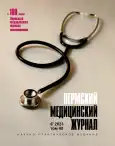Assessment of two-year survival rate after acute myocardial infarction in patients with impaired carbohydrate metabolism during novel coronavirus infection pandemic
- Authors: Maltsev А.I.1, Koryagina N.А.2, Koryagin V.S.2
-
Affiliations:
- Clinical Cardiology Dispensary
- E.A. Vagner Perm State Medical University
- Issue: Vol 40, No 6 (2023)
- Pages: 24-30
- Section: Original studies
- URL: https://journals.rcsi.science/PMJ/article/view/254783
- DOI: https://doi.org/10.17816/pmj40624-30
- ID: 254783
Cite item
Full Text
Abstract
Relevance. There are limited data on the long-term outcomes of patients with myocardial infarction (MI) and impaired glucose tolerance (IGT) during the novel coronavirus disease (COVID-19) pandemic in 2020.
Objective. To assess the 24-month survival rate among patients with IGT and previous myocardial infarction in 2020 during the COVID-19 pandemic compared to the same period in 2019.
Materials and methods. We assessed the two-year survival rate of patients with MI and IGT from 10/1/2020 to12/10/2020 during the indirect influence of the pandemic compared to the same period in pre-pandemic 2019. The study was single-center, retrospective.
Results. 179 persons in 2020 and 261 persons in 2019 with MI and IGT applied to a regional center to perform percutaneous coronary intervention (PCI center). There was an increase in mortality from MI and IGT from 4.1 % in 2019 to 9.9 % (p = 0.04) in the “pandemic” year of 2020. The relapse-free survival of patients was analyzed using the Kaplan – Meier curve method. By the end of the first year in 2020, 82.1 % of patients remained from the original, and in 2019 – 88.1 %, (p = 0.001), at the end of the 24-month observation period – 78.2 % among patients with MI in 2020 and 83.5 % in 2019, (p = 0.0015).
Conclusions. A retrospective analysis of cases with MI and IGT during a pandemic in Russia showed the worst prognoses for the two-year survival rate among patients, more severe heart attacks with increased number of complications.
Keywords
Full Text
##article.viewOnOriginalSite##About the authors
А. I. Maltsev
Clinical Cardiology Dispensary
Author for correspondence.
Email: nina11-85@mail.ru
Applicant, Department of Polyclinic Therapy, cardiologist
Russian Federation, PermN. А. Koryagina
E.A. Vagner Perm State Medical University
Email: nina11-85@mail.ru
MD, PhD, Professor, Department of Polyclinic Therapy
Russian Federation, PermV. S. Koryagin
E.A. Vagner Perm State Medical University
Email: nina11-85@mail.ru
student, Faculty of Medicine
Russian Federation, PermReferences
- Piironen M., Ukkola O., Huikuri H. et al. Trends in long-term prognosis after acute coronary syndrome. Eur J Prev Cardiol. 2017; 24: 274–280.
- Tobbia P., Brodie B.R., Witzenbichler B. et al. Adverse event rates following primary PCI for STEMI at US and non-US hospitals: three-year analysis from the HORIZONS-AMI trial. Euro Intervention. 2013; 8: 1134–1142.
- Eagle K.A., Lim M.J., Dabbous O.H. et al. A validated prediction model for all forms of acute coronary syndrome: estimating the risk of 6-month postdischarge death in an international registry. JAMA 2004; 291: 2727–2733.
- Prokhorov K.V., Koryagina N.A., Spasenkov G.N. et al. Delay in care for patients with acute myocardial infarction during the COVID-19 pandemic. Modern science: current problems of theory and practice. Series: Natural and technical sciences 2021; 8: 202–205. doi: 10.37882/2223-2966.2021.08.29 (in Russian).
- Koryagina N.A., Prokhorov K.V., Koryagin V.S., Spasenkov G.N. Decrease in emergency medical calls for myocardial infarction at the peak of the COVID-19 pandemic. Cardiological Bulletin 2022; 17 (2–2): 9 (in Russian).
- Zorzi A., Vio R., Rivezzi F. et al. Characteristics and hospital course of patients admitted for acute cardiovascular diseases during the coronavirus disease-19 outbreak. J Cardiovasc. Med. 2021; 22: 29–35. PMID: 33186239.
- Nacoti M., Ciocca A., Giupponi A. et al. At the epicenter of the Covid- 19 pandemic and humanitarian crises in Italy: changing perspectives on preparation and mitigation. NEJM Catal. 2020.
- Dunlop C., Howe A., Allen L.N. The coronavirus outbreak: the central role of primary care in emergency preparedness and response. BJGP Open 2020; 1; 4 (1): bigopen20X101041. PMID: 31992543.
- Koryagina N.A., Prokhorov K.V., Koryagin V.S., Spasenkov G.N. Outcomes of acute myocardial infarction during the COVID-19 pandemic. Cardiological Bulletin 2022; 17 (2–2): 8–9 (in Russian).
- Sukhanov M.S., Karakulova Yu.V., Prokhorov K.V. et al. Experience in using remote monitoring of patients suffering from cardiovascular diseases in the Perm region. Cardiovascular therapy and prevention 2021; 20 (3): 87–90. doi: 10.15829/1728-8800-2021-2838 (in Russian).
Supplementary files








